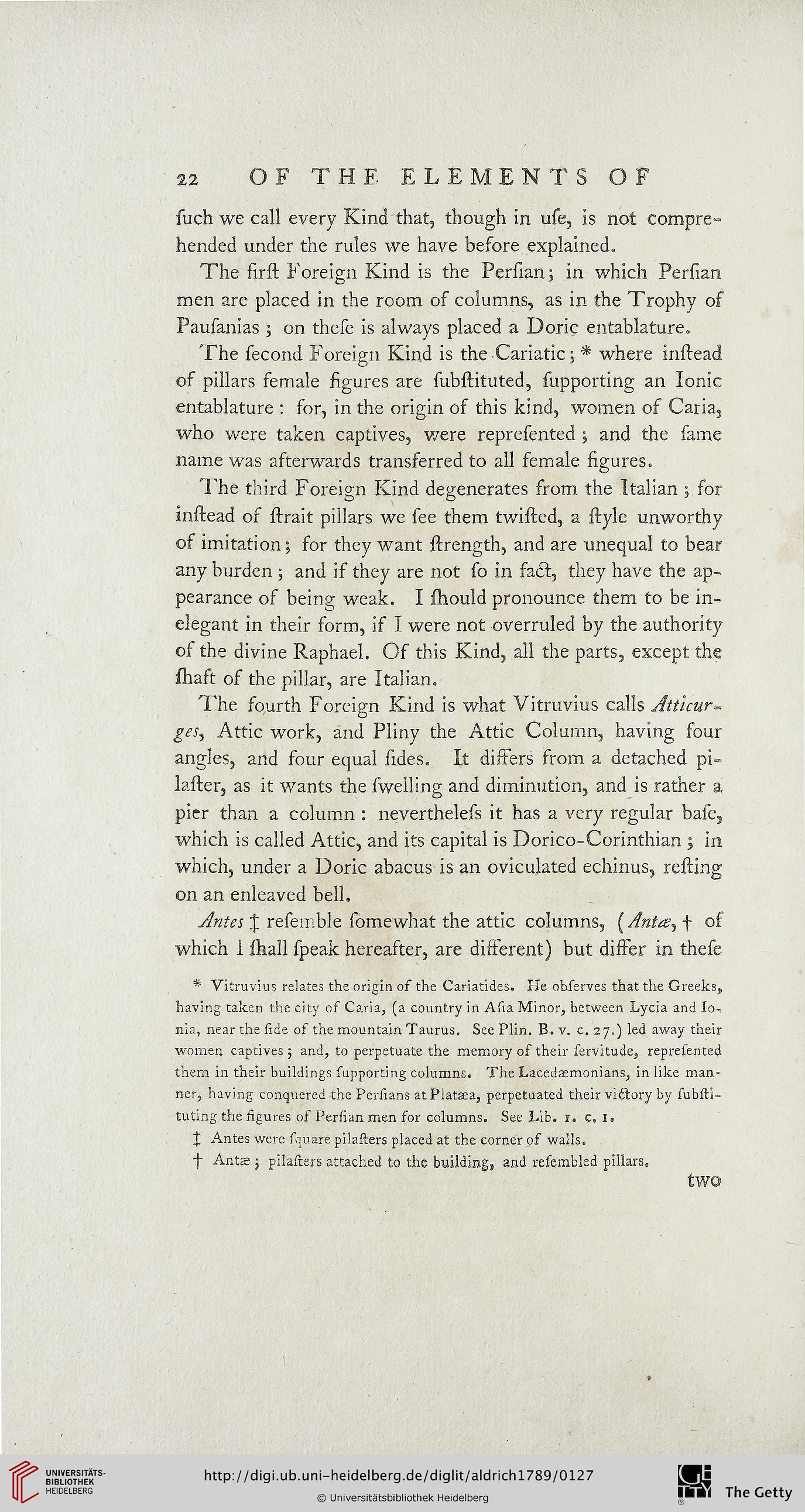22
OF THE ELEMENTS OF
such we call every Kind that, though in use, is not compre-
hended under the rules we have before explained.
The first Foreign Kind is the Persian; in which Persian
men are placed in the room of columns, as in the Trophy of
Pausanias ; on these is always placed a Doric entablature.
The second Foreign Kind is the Cariatic; * where instead
of pillars semale figures are substituted, supporting an Ionic
entablature : for, in the origin of this kind, women of Caria,
who were taken captives, were represented ; and the same
name was afterwards transferred to all female figures.
The third Foreign Kind degenerates from the Italian ; for
instead of strait pillars we see them twisted, a style unworthy
of imitation; for they want strength, and are unequal to bear
any burden ; and if they are not so in faff, they have the ap-
pearance of being weak. I should pronounce them to be in-
elegant in their form, if I were not overruled by the authority
of the divine Raphael. Of this Kind, all the parts, except the
shaft of the pillar, are Italian.
The fourth Foreign Kind is what Vitruvius calls Attlcur-
ges, Attic work, and Pliny the Attic Column, having four
angles, and four equal Tides. It differs from a detached pi-
laster, as it wants the swelling and diminution, and is rather a
pier than a column : nevertheless it has a very regular bale,
which is called Attic, and its capital is Dorico-Corinthian ; in
which, under a Doric abacus is an oviculated echinus, resting
on an enleaved bell.
Antes J resemble somewhat the attic columns, (Antes., fi of
which 1 shall speak hereafter, are different) but differ in these
* Vitruvius relates the origin os the Cariatides. He ohserves that the Greeks,
having taken the city of Caria, (a country in Asia Minor, between Lycia and Io-
nia, near the side of the mountain Taurus. See Plin. B. v. c. 27.) led away their
women captives ; and, to perpetuate the memory of their servitude, represented
them in their buildings supporting columns. The Lacedaemonians, in like man-
ner, having conquered the Persians atPlataea, perpetuated their victory by substi-
tutmg the sigures of Persian men sor columns. See Lib. 1. c, 1.
s Antes were square pilasters placed at the corner of walls,
t Ants j pilasters attached to the building, and resembled pillars.
two
OF THE ELEMENTS OF
such we call every Kind that, though in use, is not compre-
hended under the rules we have before explained.
The first Foreign Kind is the Persian; in which Persian
men are placed in the room of columns, as in the Trophy of
Pausanias ; on these is always placed a Doric entablature.
The second Foreign Kind is the Cariatic; * where instead
of pillars semale figures are substituted, supporting an Ionic
entablature : for, in the origin of this kind, women of Caria,
who were taken captives, were represented ; and the same
name was afterwards transferred to all female figures.
The third Foreign Kind degenerates from the Italian ; for
instead of strait pillars we see them twisted, a style unworthy
of imitation; for they want strength, and are unequal to bear
any burden ; and if they are not so in faff, they have the ap-
pearance of being weak. I should pronounce them to be in-
elegant in their form, if I were not overruled by the authority
of the divine Raphael. Of this Kind, all the parts, except the
shaft of the pillar, are Italian.
The fourth Foreign Kind is what Vitruvius calls Attlcur-
ges, Attic work, and Pliny the Attic Column, having four
angles, and four equal Tides. It differs from a detached pi-
laster, as it wants the swelling and diminution, and is rather a
pier than a column : nevertheless it has a very regular bale,
which is called Attic, and its capital is Dorico-Corinthian ; in
which, under a Doric abacus is an oviculated echinus, resting
on an enleaved bell.
Antes J resemble somewhat the attic columns, (Antes., fi of
which 1 shall speak hereafter, are different) but differ in these
* Vitruvius relates the origin os the Cariatides. He ohserves that the Greeks,
having taken the city of Caria, (a country in Asia Minor, between Lycia and Io-
nia, near the side of the mountain Taurus. See Plin. B. v. c. 27.) led away their
women captives ; and, to perpetuate the memory of their servitude, represented
them in their buildings supporting columns. The Lacedaemonians, in like man-
ner, having conquered the Persians atPlataea, perpetuated their victory by substi-
tutmg the sigures of Persian men sor columns. See Lib. 1. c, 1.
s Antes were square pilasters placed at the corner of walls,
t Ants j pilasters attached to the building, and resembled pillars.
two





